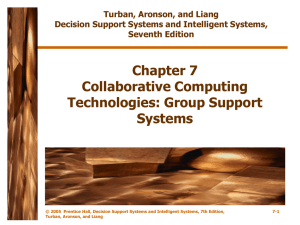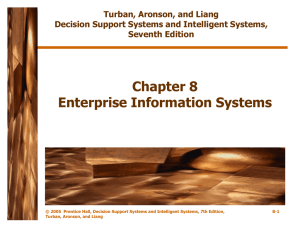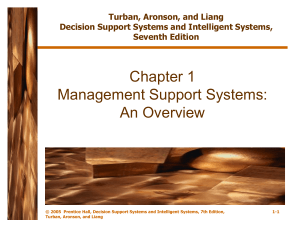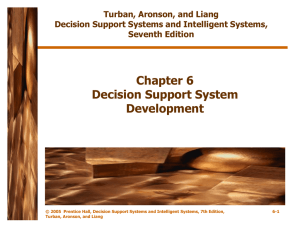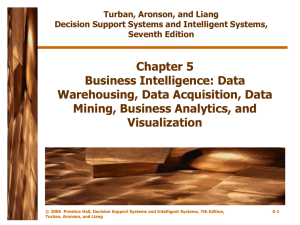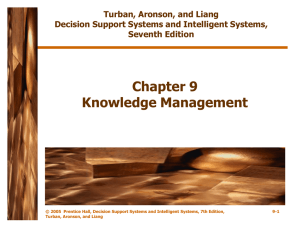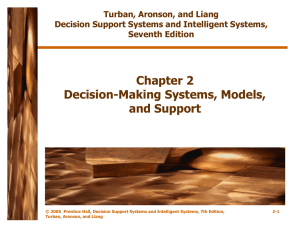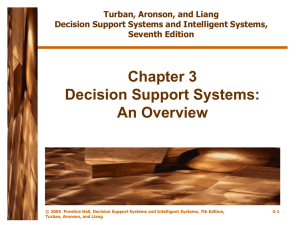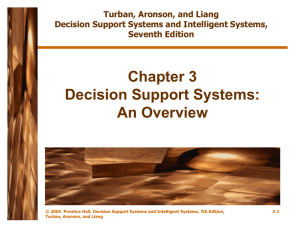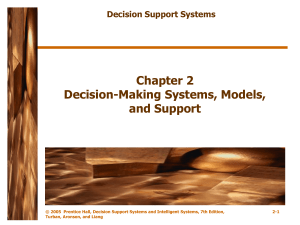Chapter 1: Management Support Systems: An Overview
advertisement
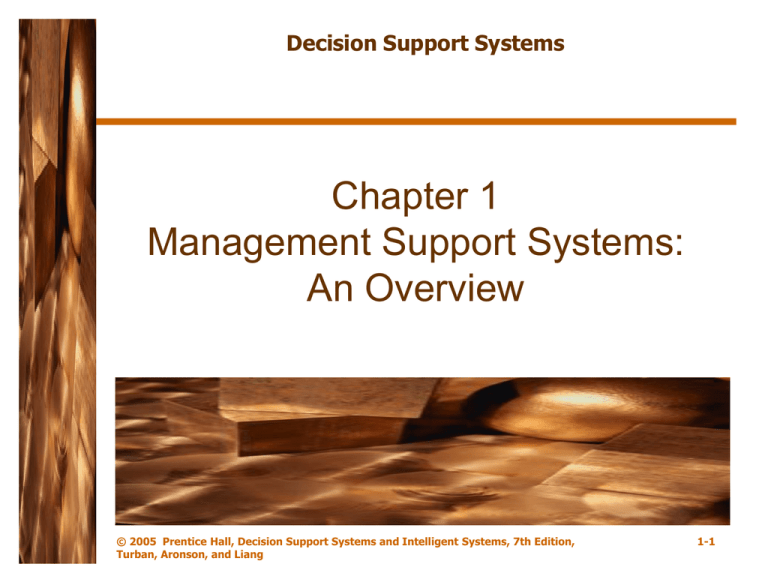
Decision Support Systems Chapter 1 Management Support Systems: An Overview © 2005 Prentice Hall, Decision Support Systems and Intelligent Systems, 7th Edition, Turban, Aronson, and Liang 1-1 Outline • 1.Managers and decision making • 2.Managerial decision making and information systems • 3.A framework for decision making • 4.The concept of decision support systems • 5. Executive Information Systems • 6. Expert Systems • 7. Knowledge management systems • 8. Hybrid support systems • 9. Emerging Technologies © 2005 Prentice Hall, Decision Support Systems and Intelligent Systems, 7th Edition, Turban, Aronson, and Liang 1-2 1.Managers and decision making Mintzberg’s 10 Management Roles • Interpersonal – Figurehead – Leader – Liaison • Informational – Monitor – Disseminator – Spokesperson • Decisional – Entrepreneur – Disturbance Handler – Resource Allocation – Negotiator © 2005 Prentice Hall, Decision Support Systems and Intelligent Systems, 7th Edition, Turban, Aronson, and Liang 1-3 Factors Affecting Decision-Making • New technologies and better information distribution have resulted in more alternatives for management. • Complex operations have increased the costs of errors, causing a chain reaction throughout the organization. • Rapidly changing global economies and markets are producing greater uncertainty and requiring faster response in order to maintain competitive advantages. • Increasing governmental regulation coupled with political destabilization have caused great uncertainty. © 2005 Prentice Hall, Decision Support Systems and Intelligent Systems, 7th Edition, Turban, Aronson, and Liang 1-4 2. Managerial Decision Making and Information Systems • Productivity is the ratio of outputs to inputs that measures the degree of success of an organization and its individual parts. • Productivity is a major concern for any organization since it determines the well-being of the organization. © 2005 Prentice Hall, Decision Support Systems and Intelligent Systems, 7th Edition, Turban, Aronson, and Liang 1-5 What do Decision Support Systems Offer? • • • • Quick computations at a lower cost Group collaboration and communication Increased productivity Ready access to information stored in multiple databases and data warehouse • Ability to analyze multiple alternatives and apply risk management • Enterprise resource management • Tools to obtain and maintain competitive advantage © 2005 Prentice Hall, Decision Support Systems and Intelligent Systems, 7th Edition, Turban, Aronson, and Liang 1-6 Cognitive Limits • The human mind has limited processing and storage capabilities. • Any single person is therefore limited in their decision making abilities. • Collaboration with others allows for a wider range of possible answers, but will often be faced with communications problems. • Computers improve the coordination of these activities. • This knowledge sharing is enhanced through the use of GSS, KMS, and EIS. © 2005 Prentice Hall, Decision Support Systems and Intelligent Systems, 7th Edition, Turban, Aronson, and Liang 1-7 Management Support Systems • The support of management tasks by the application of technologies – Sometimes called Decision Support Systems or Business Intelligence © 2005 Prentice Hall, Decision Support Systems and Intelligent Systems, 7th Edition, Turban, Aronson, and Liang 1-8 Management Support Systems Tools • • • • • • • • • • DSS Management Science Business Analytics Data Mining Data Warehouse Business Intelligence OLAP CASE tools GSS EIS (Executive IS) • EIP • ERM (Enterprise resourse management) • ERP (Enterprise resource planning) • CRM (customer relationship management) • SCM (supply chain..) • KMS (knowledge management system) • KMP • ES • ANN • Intelligent Agents • E-commerce DSS © 2005 Prentice Hall, Decision Support Systems and Intelligent Systems, 7th Edition, Turban, Aronson, and Liang 1-9 3. Decision Support Frameworks • Decision making processes fall along a continuum that ranges from highly structured to highly unstructured decision. • Structured processes are routine, and repetitive problems for which standard solution methods exist. • Unstructured processes are fuzzy, complex problems for which there are no clear-cut solution methods. • In a structured problem, the procedures for obtaining the best solution are known. • In an unstructured problem, human intuition is often the basis for decision making. © 2005 Prentice Hall, Decision Support Systems and Intelligent Systems, 7th Edition, Turban, Aronson, and Liang 1-10 Decision Support Frameworks Type of Control Type of Decision: Operational Control Managerial Control Strategic Planning Structured Accounts receivable, accounts payable, order entry Budget analysis, short-term forecasting, personnel reports Investments, warehouse locations, distribution centers Semistructured Production scheduling, inventory control Credit evaluation, budget preparation, project scheduling, rewards systems Mergers and acquisitions, new product planning, compensation, QA, HR policy planning Unstructured (Unprogrammed) Buying software, approving loans, help desk Negotiations, recruitment, hardware purchasing R&D planning, technology development, social responsibility plans (Programmed) © 2005 Prentice Hall, Decision Support Systems and Intelligent Systems, 7th Edition, Turban, Aronson, and Liang 1-11 Technologies for Decision-Making Processes Type of Decision Technology Support Needed Structured (Programmed) MIS, Management Science Models, Transaction Processing Semistructured DSS, KMS, GSS, CRM, SCM Unstructured (Unprogrammed) GSS, KMS, ES, Neural networks GSS: Group Support System © 2005 Prentice Hall, Decision Support Systems and Intelligent Systems, 7th Edition, Turban, Aronson, and Liang 1-12 Technology Support Based on Anthony’s Taxonomy Type of Control Technology Support Needed Operational Control Managerial Control Strategic Planning MIS, Management Science Management Science, DSS, ES, EIS, SCM, CRM, GSS, SCM GSS, CRM, EIS, ES, neural networks, KMS © 2005 Prentice Hall, Decision Support Systems and Intelligent Systems, 7th Edition, Turban, Aronson, and Liang 1-13 © 2005 Prentice Hall, Decision Support Systems and Intelligent Systems, 7th Edition, Turban, Aronson, and Liang 1-14 Management Science/Operations Research • Adopts systematic approach with the following steps: – – – – Define the problem Classify the problem into standard category Construct a mathematical model Find potential solutions to the modeled problem and evaluate them – Select a solution to the problem © 2005 Prentice Hall, Decision Support Systems and Intelligent Systems, 7th Edition, Turban, Aronson, and Liang 1-15 4.The concept of Decision Support Systems • “Decision support systems couple the intellectual resources of individuals with the capacities of the computer to improve the quality of decisions. It is a computer-based support system for management decision makers who deal with semi-structured problems.” [Keen and Scott Morton, 1978] • There is no universally accepted definition of DSS. • DSS is an umbrella term. © 2005 Prentice Hall, Decision Support Systems and Intelligent Systems, 7th Edition, Turban, Aronson, and Liang 1-16 5. Enterprise Information Systems • Evolved from Executive Information Systems combined with Web technologies • EIPs view information across entire organizations • Provide rapid access to detailed information through drill-down. • Provide user-friendly interfaces through portals. • Identifies opportunities and threats © 2005 Prentice Hall, Decision Support Systems and Intelligent Systems, 7th Edition, Turban, Aronson, and Liang 1-17 Enterprise Information Systems • Specialized systems include ERM, ERP, CRM, and SCM • Provides timely and effective corporate level tracking and control. • Filter, compress, and track critical data and information. ERM: Enterprise Resource Management CRM: Customer Relationship Management SCM: Supply Chain Management © 2005 Prentice Hall, Decision Support Systems and Intelligent Systems, 7th Edition, Turban, Aronson, and Liang 1-18 6. Expert Systems • Technologies that apply reasoning methodologies in a specific domain • Attempts to mimic human experts’ problem solving • Expertise is transferred from the expert to a computer. • ESs consist of knowledge-base and inference engine. • Examples include: – – – – – Artificial Intelligence Systems Artificial Neural Networks (neural computing) Genetic Algorithms Fuzzy Logic Intelligent Agents © 2005 Prentice Hall, Decision Support Systems and Intelligent Systems, 7th Edition, Turban, Aronson, and Liang 1-19 7. Knowledge Management Systems • Knowledge that is organized and stored in a repository for use by an organization • Can be used to solve similar or identical problems in the future • Knowledge management systems appears in a variety of formats, and they can be used to support decision making in several ways. Knowledge base Knowledge asquisition © 2005 Prentice Hall, Decision Support Systems and Intelligent Systems, 7th Edition, Turban, Aronson, and Liang 1-20 8. Hybrid Support Systems • Integration of different computer system tools to resolve problems • Tools perform different tasks, but support each other • Together, produce more sophisticated answers • Work together to produce smarter answers • Tightly integrated systems or loosely integrated systems. © 2005 Prentice Hall, Decision Support Systems and Intelligent Systems, 7th Edition, Turban, Aronson, and Liang 1-21 9.Emerging Technologies • • • • • • • Grid computing Improved GUIs Model-driven architectures with code reuse Wireless computing Intelligent agents Genetic algorithms Metaheuristics and new problem-solving techniques © 2005 Prentice Hall, Decision Support Systems and Intelligent Systems, 7th Edition, Turban, Aronson, and Liang 1-22
